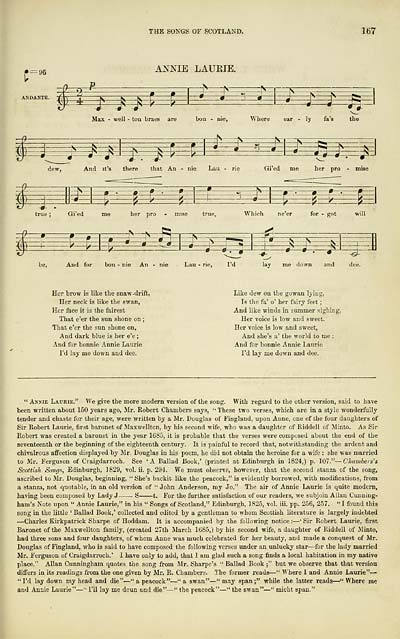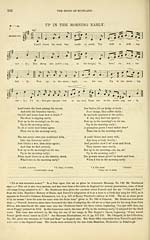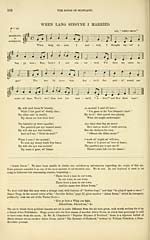Glen Collection of printed music > Printed music > Wood's edition of the songs of Scotland
(191) Page 167 - Annie Laurie
Download files
Complete book:
Individual page:
Thumbnail gallery: Grid view | List view

THE SONGS OF SCOTLAND.
167
.• = 96
1/
ANNIE LAUEIE.
i ^feppg^ ^m^^f
Max - well - ton braes are bon - nie,
Where ear - ly fa's the
l=^Pi=P=i
-3=±
dew,
And it's there that An - nie Lau. - rie
Gi'ed me her pro - mise
B=
true ;
-8^
H^i=l=E=l
Gi'ed me her pro - mise true,
-*=•
£=*=aS=
Which ne'er for - got will
i=fe=P=
a^e
-* — m-
lay me down and dee.
be, And for bon - nie An - nie Lau - rie, I'd
Her brow is like the snaw-drift,
Her neck is like the swan,
Her face it is the fairest
That e'er the sun shone on ;
That e'er the sun shone on,
And dark blue is hev e'e ;
And for bonnie Annie Laurie
I'd lay me down and dee.
Like dew on the gowan lying,
Is the fa' o' her fairy feet ;
And like winds in summer sighing.
Her voice is low and sweet.
Her voice is low and sweet,
And she's a' the world to me ;
And for bonnie Annie Laurie
I'd lay me down and dee.
" Annie Laurie." We give the more modern version of the song. With regard to the other version, said to have
been written about 160 years ago, Mr. Robert Chambers says, "These two verses, which are in a style wonderfully
tender and chaste for their age, were written by a Mr. Douglas of Fingland, upon Anne, one of the four daughters of
Sir Robert Laurie, first baronet of Maxwellton, by his second wife, who was a daughter of Riddell of Minto. As Sir
Robert was created a baronet in the year 1685, it is probable that the verses were composed about the end of the
seventeenth or the beginning of the eighteenth century. It is painful to record that, notwithstanding the ardent and
chivalrous affection displayed by Mr. Douglas in his poem, he did not obtain the heroine for a wife : she was married
to Mr. Ferguson of Craigdarroch. See ' A Ballad Book,' (printed at Edinburgh in 1824,) p. 107." — Chambers's
Scottish Songs, Edinburgh, 1829, vol. ii. p. 294. We must observe, however, that the second stanza of the song,
ascribed to Mr. Douglas, beginning. " She's backit like the peacock," is evidently borrowed, with modifications, from
a stanza, not quotable, in an old version of " John Anderson, my Jo." The air of Annie Laurie is quite modern,
having been composed by Lady J S 1. For the further satisfaction of our readers, we subjoin Allan Cunning-
ham's Note upon " Annie Laurie," in his " Songs of Scotland," Edinburgh, 1825, vol. iii. pp. 256, 257. " I found this
song in the little ' Ballad Book,' collected and edited by a gentleman to whom Scottish literature is largely indebted
— Charles Kirkpatrick Sharpe of Hoddam. It is accompanied by the following notice : — ' Sir Robert Laurie, first
Baronet of the Maxwellton family, (created 27th March 1685,) by his second wife, a daughter of Riddell of Minto,
had three sons and four daughters, of whom Anne was much celebrated for her beauty, and made a conquest of Air.
Douglas of Fingland, who is said to have composed the following verses under an unlucky star — for the lady married
Mr. Ferguson of Craigdarroch.' I have only to add, that I am glad such a song finds a local habitation in my native
place." Allan Cunningham quotes the song from Mr. Sharpe's " Ballad Book ;" but we observe that that version
differs in its readings from the one given by Mr. R. Chambers. The former reads — " Where I and Annie Laurie" —
"I'd lay down my head and die" — "a peacock" — "a swan" — "may span;" while the latter reads — "Where me
and Annie Laurie" — " I'll lay me doun and die"—" the peacock" — " the swan" — " micht span."
167
.• = 96
1/
ANNIE LAUEIE.
i ^feppg^ ^m^^f
Max - well - ton braes are bon - nie,
Where ear - ly fa's the
l=^Pi=P=i
-3=±
dew,
And it's there that An - nie Lau. - rie
Gi'ed me her pro - mise
B=
true ;
-8^
H^i=l=E=l
Gi'ed me her pro - mise true,
-*=•
£=*=aS=
Which ne'er for - got will
i=fe=P=
a^e
-* — m-
lay me down and dee.
be, And for bon - nie An - nie Lau - rie, I'd
Her brow is like the snaw-drift,
Her neck is like the swan,
Her face it is the fairest
That e'er the sun shone on ;
That e'er the sun shone on,
And dark blue is hev e'e ;
And for bonnie Annie Laurie
I'd lay me down and dee.
Like dew on the gowan lying,
Is the fa' o' her fairy feet ;
And like winds in summer sighing.
Her voice is low and sweet.
Her voice is low and sweet,
And she's a' the world to me ;
And for bonnie Annie Laurie
I'd lay me down and dee.
" Annie Laurie." We give the more modern version of the song. With regard to the other version, said to have
been written about 160 years ago, Mr. Robert Chambers says, "These two verses, which are in a style wonderfully
tender and chaste for their age, were written by a Mr. Douglas of Fingland, upon Anne, one of the four daughters of
Sir Robert Laurie, first baronet of Maxwellton, by his second wife, who was a daughter of Riddell of Minto. As Sir
Robert was created a baronet in the year 1685, it is probable that the verses were composed about the end of the
seventeenth or the beginning of the eighteenth century. It is painful to record that, notwithstanding the ardent and
chivalrous affection displayed by Mr. Douglas in his poem, he did not obtain the heroine for a wife : she was married
to Mr. Ferguson of Craigdarroch. See ' A Ballad Book,' (printed at Edinburgh in 1824,) p. 107." — Chambers's
Scottish Songs, Edinburgh, 1829, vol. ii. p. 294. We must observe, however, that the second stanza of the song,
ascribed to Mr. Douglas, beginning. " She's backit like the peacock," is evidently borrowed, with modifications, from
a stanza, not quotable, in an old version of " John Anderson, my Jo." The air of Annie Laurie is quite modern,
having been composed by Lady J S 1. For the further satisfaction of our readers, we subjoin Allan Cunning-
ham's Note upon " Annie Laurie," in his " Songs of Scotland," Edinburgh, 1825, vol. iii. pp. 256, 257. " I found this
song in the little ' Ballad Book,' collected and edited by a gentleman to whom Scottish literature is largely indebted
— Charles Kirkpatrick Sharpe of Hoddam. It is accompanied by the following notice : — ' Sir Robert Laurie, first
Baronet of the Maxwellton family, (created 27th March 1685,) by his second wife, a daughter of Riddell of Minto,
had three sons and four daughters, of whom Anne was much celebrated for her beauty, and made a conquest of Air.
Douglas of Fingland, who is said to have composed the following verses under an unlucky star — for the lady married
Mr. Ferguson of Craigdarroch.' I have only to add, that I am glad such a song finds a local habitation in my native
place." Allan Cunningham quotes the song from Mr. Sharpe's " Ballad Book ;" but we observe that that version
differs in its readings from the one given by Mr. R. Chambers. The former reads — " Where I and Annie Laurie" —
"I'd lay down my head and die" — "a peacock" — "a swan" — "may span;" while the latter reads — "Where me
and Annie Laurie" — " I'll lay me doun and die"—" the peacock" — " the swan" — " micht span."
Set display mode to: Large image | Transcription
Images and transcriptions on this page, including medium image downloads, may be used under the Creative Commons Attribution 4.0 International Licence unless otherwise stated. ![]()
| Special collections of printed music > Glen Collection of printed music > Printed music > Wood's edition of the songs of Scotland > (191) Page 167 - Annie Laurie |
|---|
| Permanent URL | https://digital.nls.uk/91340035 |
|---|
| Description | Scottish songs and music of the 18th and early 19th centuries, including music for the Highland bagpipe. These are selected items from the collection of John Glen (1833 to 1904). Also includes a few manuscripts, some treatises, and other books on the subject. |
|---|
| Description | The Glen Collection and the Inglis Collection represent mainly 18th and 19th century Scottish music, including Scottish songs. The collections of Berlioz and Verdi collected by bibliographer Cecil Hopkinson contain contemporary and later editions of the works of the two composers Berlioz and Verdi. |
|---|

